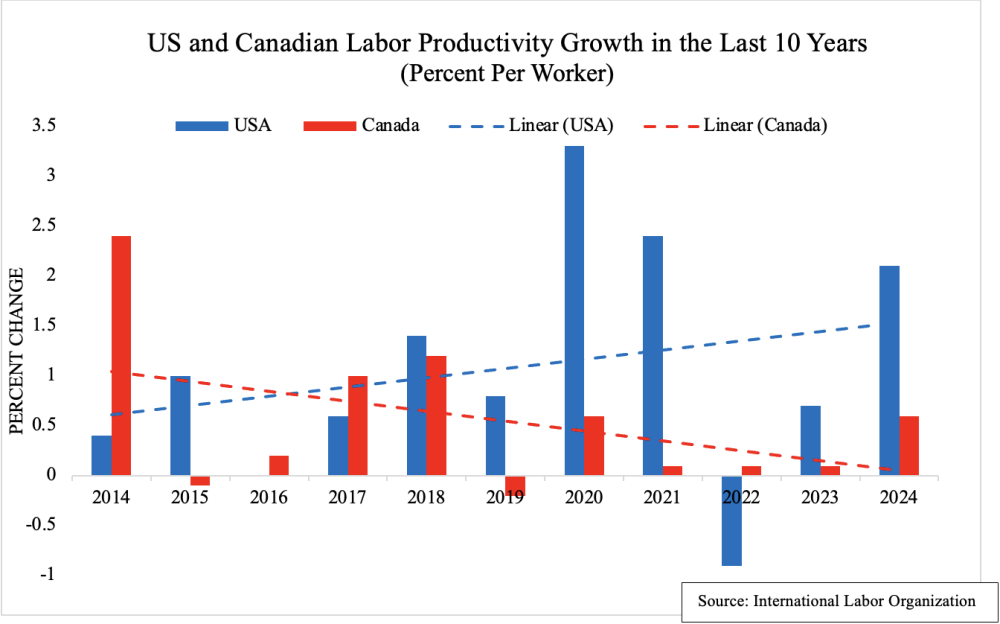The Canadian economy is facing significant challenges, from housing prices to inflation, but one critical and lesser-known problem is the declining growth in labor productivity. In March, Carolyn Rodgers, senior deputy governor at the Bank of Canada, emphasized this crucial issue, stating, "Canada's need to improve productivity has reached emergency levels." That announcement followed six consecutive quarters of decline. If this issue is not addressed, productivity regression threatens to hinder economic growth and diminish living standards across the country.
Productivity measures performance by comparing the output of a product to the inputs—such as labor, equipment, or money—required for its production. This article primarily examines the reasons behind the lag in labor productivity, which is determined by dividing the national GDP by the total hours worked in the economy. Additionally, declining capital productivity, which measures how efficiently physical capital is used to generate output, and public sector productivity, which assesses the efficiency and effectiveness of the public sector, also play significant roles in Canada’s slowing productivity rate.
Sluggish productivity growth in the Canadian economy stems from insufficient levels of investment, limited innovation, and persistent structural barriers. The Trudeau government's 2024 budget included measures to boost productivity by allocating funds for investments in AI and research grants. However, more drastic measures are needed to confront this challenge effectively, and these efforts will dictate Canada's long-term economic outlook.
Productivity is important because it is one of the best indicators for forecasting future economic performance. A higher labor productivity rate means that the workforce produces greater output with fewer resources, which enhances competitiveness and economic growth and, in the long term, results in higher wages and improved living standards. Conversely, low productivity leads to slow wage growth, diminished economic expansion, and challenges in controlling inflation through monetary policy.
The height of Canadian productivity was in the 1950s when rates averaged 5% of GDP. The rate has been slowly declining since the 1970s and hovering around 1% of GDP since the early 2000s. However, the recent trend is more troubling, as productivity has remained stagnant at around 0% in the last five years.
Causes
Global events have aggravated Canada's productivity challenges. The financial crisis of 2008-2009, the 2015 oil crisis, and the COVID-19 pandemic have all negatively impacted the economy and caused slowdowns. Other global disruptions, like the shift to remote work and supply chain strains from the war in Ukraine, have recently contributed to lower productivity levels. These trends suggest that this economic underperformance will continue in the decade ahead.
Slowing public sector productivity, caused by national inefficiencies within government regulations and administrative processes also stifle economic growth. Throughout Canada, provincial regulations vary, which creates barriers to interprovincial trade and inflates operational costs. Additionally, sectors of the economy are notoriously slow, including turnaround times at ports and delays in major infrastructure projects such as pipelines and transportation networks. These issues are reflected in the World Bank's ease of doing business index rankings as Canada ranks 23rd, far behind the United States, which ranks sixth. That measure underscores the need for streamlined regulatory frameworks throughout the country.
One of the most significant reasons for Canada's low productivity growth is a lack of investment. Compared to the United States, Canadian firms invest significantly less than their American counterparts. Government funds are not making up for this lack of investment, as money is often directed toward less productive sectors to address pressing economic problems. For example, construction to address the housing crisis and retail and hospitality to address demographic shifts from immigration. Other government-run sectors of the economy, like education and healthcare, are also not receiving adequate investment, contributing to lower public sector productivity levels. Further, trends of foreign investment abroad have caused a significant flow of money out of the country.
Another reason for Canada's declining capital productivity growth is a lag in businesses adopting innovation, a problem linked to the country's economic structure. Within the Canadian economy, a handful of firms dominate the markets, particularly in the banking, telecommunications, and energy sectors. This oligopolistic architecture means only the largest companies have the resources to innovate and these benefits are not shared throughout the market. Further, according to the Bank of Canada, most Canadian businesses (98%) have fewer than 100 employees. Small businesses are typically less productive and innovative than large companies and struggle to grow due to the oligopolistic structure of the markets.
Finally, structural challenges, including Canada's vast geography and harsh climate, pose additional hurdles. The population is spread across large distances, complicating transportation efficiency. Harsh winters only exacerbate these challenges.
Comparison with the United States
A comparison between US and Canadian economies is often drawn due to their similar geopolitical position, common values, financial systems, and government policies. When comparing the productivity trajectory in both nations, Canada is falling behind. In the last ten years, both countries' productivity rates have fluctuated between positive and negative. However, the United States has averaged a steady increase, while in Canada, three years of rates at 0.1% (2021-2023)have generated a productivity decrease.

However, this problem has persisted for longer than the past ten years. The Business Council of British Columbia reports that in 2000, the Canadian economy was 82% as productive as the American economy; by 2020, that rate had decreased to 77%. This data suggests that conditions in Canada hinder economic growth beyond the residual effects of global challenges.
The International Labor Organization ranks countries by labor productivity levels. The United States is ranked 13th, and Canada is ranked 26th, tied with Spain and Hong Kong. The United States maintained high productivity in the pandemic’s aftermath, a phenomenon that remains somewhat of a mystery to policymakers. Ultimately, the United States’ ability to maintain productivity growth stems from high levels of investment, innovation-driven advancements, flexible labor mobility, and efficient transportation networks.
The substantial integration between US and Canadian economies means that lagging Canadian economic productivity will have a direct impact on the United States. If this issue worsens, it could negatively affect sectors reliant on cross-border trade and investment.
Conclusion
Addressing Canada's productivity lag demands comprehensive strategies. Economists advocate for the public sector to redact interprovincial trade barriers, streamline regulations to eliminate inefficiencies, and implement tax reforms to incentivize domestic investment. The public and private sector prioritizing innovation in AI and critical industries as well as capitalizing on Canada's highly educated workforce and abundant natural resources offer further avenues for productivity growth. However, the impact of these policies on businesses and workers will vary; the benefits will only be felt throughout the economy if they are equitably shared with workers.
Additionally, Canada can look to other countries for solutions, such as Australia, which in recent years has boosted their productivity levels, through a government-led productivity commission to provide frameworks for policy reform.
Canada has a solid economic foundation and can support productivity growth. It is the ninth largest economy in the world with high levels of GDP per capita. However, meaningful efforts must be made by the government and private sector to change the current trend. Policies that encourage innovation and investment in the Canadian economy will ensure growth and improve Canadians' quality of life in the years to come.
Author


Canada Institute
The mission of the Wilson Center's Canada Institute is to raise the level of knowledge of Canada in the United States, particularly within the Washington, DC policy community. Research projects, initiatives, podcasts, and publications cover contemporary Canada, US-Canadian relations, North American political economy, and Canada's global role as it intersects with US national interests. Read more

Explore More
Browse Insights & Analysis
360° View of How Southeast Asia Can Attract More FDI in Chips and AI



